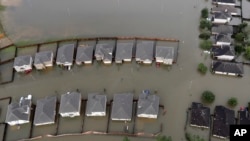Energy companies, homeowners, and others are calculating the cost of Hurricane Harvey, which has already boosted gasoline prices and may slow the growth of the huge U.S. economy.
Gasoline prices surged to a two-year high recently as record floods forced refineries and other oil industry operations to close in Texas and elsewhere.
Oil industry analysts say nearly one-quarter of the U.S. refining capacity is shut, which prompted worries about future supplies and rising prices. Crude oil prices sagged because closed refineries mean lower demand for this raw material. Some analysts predicted the price hikes would be temporary, but cautioned it is not yet clear how much damage has been done to some of the world's largest refineries.
The total cost of the disaster is unclear because floodwaters are still rising and officials have been focused on rescuing people not assessing damage to facilities. Preliminary estimates vary widely, and run into the tens of billions of dollars.
Some of that cost comes from closed airports that normally handle 1,600 or more flights per day. Other losses come from the closed shipping facilities that normally see thousands of containers and considerable oil that normally moves through Houston and nearby areas each day.
Data analysis expert Josh Green of Pajjiva said there is likely to be a major impact on the local community, but shippers will find alternate ports for cargos, which will limit the damage to the national economy.
Billionaire Warren Buffett, one of the world's most astute and successful investors, told CNBC, a financial news channel, the storm has caused serious destruction, but the toll is probably less than one percent of the U.S. GDP.
Wednesday, the Commerce Department said U.S. economic growth had sped up to a three percent annual rate in the second quarter (April, May and June) which is faster than first estimated.
Analysts at Macroeconomic Advisers say Harvey could cut anywhere from three-tenths of a percent to more than one percent from growth in the third quarter (July, August, September).
IHS Markit Chief Economist Nariman Behravesh said previous storms have hurt short-term growth, which has eventually been offset by an economic boost from reconstruction activity. He said the many uncertainties about the extent of damage will make economic estimates "volatile" for the last six months of this year.
Cornell University business professor Steven Kyle told VOA some economic tools do a poor job of measuring the impact of disasters because they count the reconstruction work as an economic gain, but do not have an accurate way to measure the cost of lost bridges, homes and workplaces.
Kyle also said the impact of the storm is not going to show up in unemployment data till the end of September.
The newest U.S. jobless rate will be published by government experts this Friday, but that information was gathered before the storm hit. Economists predict the jobless rate for August will be a very low, at 4.3 percent.










